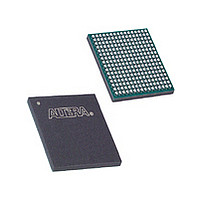EPM7256AEFC256-10N Altera, EPM7256AEFC256-10N Datasheet - Page 20

EPM7256AEFC256-10N
Manufacturer Part Number
EPM7256AEFC256-10N
Description
IC PLD EEPROM 256 MACROCELL FBGA-256
Manufacturer
Altera
Series
MAX 7000AEr
Datasheet
1.EPM7032AELC44-10N.pdf
(64 pages)
Specifications of EPM7256AEFC256-10N
Cpld Type
EEPROM
No. Of Macrocells
256
No. Of I/o's
164
Propagation Delay
10ns
Global Clock Setup Time
3.9ns
Frequency
172.4MHz
Supply Voltage Range
3V To 3.6V
Family Name
MAX 7000A
Memory Type
EEPROM
# Macrocells
256
Number Of Usable Gates
5000
Frequency (max)
125MHz
Propagation Delay Time
10ns
Number Of Logic Blocks/elements
16
# I/os (max)
164
Operating Supply Voltage (typ)
3.3V
In System Programmable
Yes
Operating Supply Voltage (min)
3V
Operating Supply Voltage (max)
3.6V
Operating Temp Range
0C to 70C
Operating Temperature Classification
Commercial
Mounting
Surface Mount
Pin Count
256
Package Type
FBGA
Rohs Compliant
Yes
Lead Free Status / RoHS Status
Lead free / RoHS Compliant
Lead Free Status / RoHS Status
Lead free / RoHS Compliant
Available stocks
Company
Part Number
Manufacturer
Quantity
Price
Part Number:
EPM7256AEFC256-10N
Manufacturer:
ALTERA/阿尔特拉
Quantity:
20 000
MAX 7000A Programmable Logic Device Data Sheet
Note to tables:
(1)
Programming
with External
Hardware
IEEE Std.
1149.1 (JTAG)
Boundary-Scan
Support
20
EPM7128A
EPM7256A
Table 7. MAX 7000A Stand-Alone Verification Times for Different Test Clock Frequencies
EPM7032AE
EPM7064AE
EPM7128AE
EPM7256AE
EPM7512AE
EPM7128A and EPM7256A devices can only be programmed with an adaptive algorithm; users programming these
two devices on platforms that cannot use an adaptive algorithm should use EPM7128AE and EPM7256AE devices.
Device
(1)
(1)
f
f
10 MHz
0.00
0.01
0.01
0.02
0.03
0.08
0.13
MAX 7000A devices can be programmed on Windows-based PCs with an
Altera Logic Programmer card, the MPU, and the appropriate device
adapter. The MPU performs continuity checks to ensure adequate
electrical contact between the adapter and the device.
For more information, see the
The Altera software can use text- or waveform-format test vectors created
with the Altera Text Editor or Waveform Editor to test the programmed
device. For added design verification, designers can perform functional
testing to compare the functional device behavior with the results of
simulation.
Data I/O, BP Microsystems, and other programming hardware
manufacturers provide programming support for Altera devices.
For more information, see
MAX 7000A devices include the JTAG BST circuitry defined by IEEE Std.
1149.1.
devices. The pin-out tables, available from the Altera web site
(http://www.altera.com), show the location of the JTAG control pins for
each device. If the JTAG interface is not required, the JTAG pins are
available as user I/O pins.
5 MHz
0.01
0.01
0.02
0.03
0.06
0.14
0.24
Table 8
2 MHz
0.01
0.02
0.04
0.08
0.15
0.29
0.54
describes the JTAG instructions supported by MAX 7000A
1 MHz
0.02
0.04
0.07
0.15
0.30
0.56
1.06
f
Programming Hardware
TCK
500 kHz
0.04
0.07
0.14
0.30
0.60
1.09
2.08
Altera Programming Hardware Data Sheet.
200 kHz
0.09
0.18
0.34
0.75
1.49
2.67
5.15
100 kHz
10.27
0.18
0.35
0.68
1.49
2.97
5.31
Manufacturers.
Altera Corporation
50 kHz
10.59
20.51
0.36
0.70
1.36
2.98
5.94
Units
s
s
s
s
s
s
s














